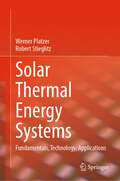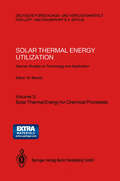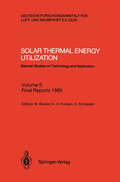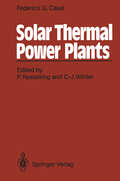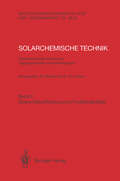- Table View
- List View
Solar Technology: The Earthscan Expert Guide to Using Solar Energy for Heating, Cooling and Electricity (Earthscan Expert)
by David ThorpeSolar energy is free, abundant and sustainable, with many methods existing to harness it. This guide is the essential introduction to the subject, explaining how the technologies work, how best they should be employed, and the costs and benefits of using them. It provides detailed yet accessible coverage of: passive solar building solar water heating solar space heating other solar thermal applications (such as cooling and desalination) grid-connected photovoltaics stand-alone photovoltaics. It also introduces the reader to larger scale applications such as concentrating solar power. Highly illustrated in full colour, this is the perfect primer for anyone who wants to work with or simply learn more about solar technologies.
Solar Technology: The Earthscan Expert Guide to Using Solar Energy for Heating, Cooling and Electricity (Earthscan Expert)
by David ThorpeSolar energy is free, abundant and sustainable, with many methods existing to harness it. This guide is the essential introduction to the subject, explaining how the technologies work, how best they should be employed, and the costs and benefits of using them. It provides detailed yet accessible coverage of: passive solar building solar water heating solar space heating other solar thermal applications (such as cooling and desalination) grid-connected photovoltaics stand-alone photovoltaics. It also introduces the reader to larger scale applications such as concentrating solar power. Highly illustrated in full colour, this is the perfect primer for anyone who wants to work with or simply learn more about solar technologies.
Solar Technology and Global Environmental Justice: The Vision and the Reality (Routledge Studies in Environmental Justice)
by Andreas RoosBuilding on insights from ecological economics and philosophy of technology, this book offers a novel, interdisciplinary approach to understand the contradictory nature of Solar photovoltaic (PV) technology. Solar photovoltaic (PV) technology is rapidly emerging as a cost-effective option in the world economy. However, reports about miserable working conditions, environmentally deleterious mineral extraction and toxic waste dumps corrode the image of a problem-free future based on solar power. Against this backdrop, Andreas Roos explores whether ‘ecologically unequal exchange’ – an asymmetric transfer of labour time and natural resources – is a necessary condition for solar PV development. He demonstrates how the massive increase in solar PV installation over recent years would not have been possible without significant wage/price differences in the world economy - notably between Europe/North America and Asia- and concludes that solar PV development is currently contingent on environmental injustices in the world economy. As a solution, Roos argues that solar technology is best coupled with strategies for degrowth, which allow for a transition away from fossil fuels and towards a socially just and ecologically sustainable future. This book will be of great interest to students and scholars of solar power, philosophy of technology, and environmental justice.
Solar Technology and Global Environmental Justice: The Vision and the Reality (Routledge Studies in Environmental Justice)
by Andreas RoosBuilding on insights from ecological economics and philosophy of technology, this book offers a novel, interdisciplinary approach to understand the contradictory nature of Solar photovoltaic (PV) technology. Solar photovoltaic (PV) technology is rapidly emerging as a cost-effective option in the world economy. However, reports about miserable working conditions, environmentally deleterious mineral extraction and toxic waste dumps corrode the image of a problem-free future based on solar power. Against this backdrop, Andreas Roos explores whether ‘ecologically unequal exchange’ – an asymmetric transfer of labour time and natural resources – is a necessary condition for solar PV development. He demonstrates how the massive increase in solar PV installation over recent years would not have been possible without significant wage/price differences in the world economy - notably between Europe/North America and Asia- and concludes that solar PV development is currently contingent on environmental injustices in the world economy. As a solution, Roos argues that solar technology is best coupled with strategies for degrowth, which allow for a transition away from fossil fuels and towards a socially just and ecologically sustainable future. This book will be of great interest to students and scholars of solar power, philosophy of technology, and environmental justice.
Solar Textiles: The Flexible Solution for Solar Power (Textile Institute Professional Publications)
by Robert Mather John WilsonMost photovoltaic (PV) installations utilise heavy conventional glass or polycarbonate panels, and even newly developed thin plastic or metal films for PV cell use may fracture during both construction and application. Textile fabrics, the most widespread flexible materials in everyday use, offer a solution to the need for lightweight, flexible solar PV generators. Solar Textiles: The Flexible Solution for Solar Power is about the incorporation and operation of solar cells on textile fabrics. The combination of textile manufacturing and solar PV cell technology opens up further avenues for both the textile and semiconductor industries. Thus, this book reflects the progressively increasing commercial interest in PV cell technology and the versatility that their integration in textiles provides. Discusses textiles as electrical substrates Explains the photovoltaic effect and associated parameters Offers special consideration of solar cells on textiles Compares fibres and fabrics and how to implement PV activity on a textile Describes manufacturing methods outside of semiconductor technology Includes applications open only to textiles This work is aimed at textile technologists, electronic engineers, solar technologists, civil engineers and designers in building fabrics and architecture.
Solar Textiles: The Flexible Solution for Solar Power (Textile Institute Professional Publications)
by Robert Mather John WilsonMost photovoltaic (PV) installations utilise heavy conventional glass or polycarbonate panels, and even newly developed thin plastic or metal films for PV cell use may fracture during both construction and application. Textile fabrics, the most widespread flexible materials in everyday use, offer a solution to the need for lightweight, flexible solar PV generators. Solar Textiles: The Flexible Solution for Solar Power is about the incorporation and operation of solar cells on textile fabrics. The combination of textile manufacturing and solar PV cell technology opens up further avenues for both the textile and semiconductor industries. Thus, this book reflects the progressively increasing commercial interest in PV cell technology and the versatility that their integration in textiles provides. Discusses textiles as electrical substrates Explains the photovoltaic effect and associated parameters Offers special consideration of solar cells on textiles Compares fibres and fabrics and how to implement PV activity on a textile Describes manufacturing methods outside of semiconductor technology Includes applications open only to textiles This work is aimed at textile technologists, electronic engineers, solar technologists, civil engineers and designers in building fabrics and architecture.
Solar Thermal Conversion Technologies for Industrial Process Heating
by T. V. Arjunan Vijayan Selvaraj M. M. MatheswaranSolar Thermal Conversion Technologies for Industrial Process Heating presents a comprehensive look at the use of solar thermal energy in industrial applications, such as textiles, chemical processing, and food. The successful projects implemented in a variety of industries are shown in case studies, alongside performance assessment methodologies. The book includes various solar thermal energy conversion technologies and new techniques and applications of solar collectors in industrial sectors. Features: Covers the key designs and novel technologies employed in the processing industries Discusses challenges in the incorporation of the solar thermal system in industrial applications Explores the techno-economic, environmental impact and life cycle analysis with government policies for promoting the system Includes real-world case studies Presents chapters written by global experts in the field The book will be useful for researchers, graduate students, and industry professionals with an aim to promote mutual understanding between sectors dealing with solar thermal energy.
Solar Thermal Conversion Technologies for Industrial Process Heating
Solar Thermal Conversion Technologies for Industrial Process Heating presents a comprehensive look at the use of solar thermal energy in industrial applications, such as textiles, chemical processing, and food. The successful projects implemented in a variety of industries are shown in case studies, alongside performance assessment methodologies. The book includes various solar thermal energy conversion technologies and new techniques and applications of solar collectors in industrial sectors. Features: Covers the key designs and novel technologies employed in the processing industries Discusses challenges in the incorporation of the solar thermal system in industrial applications Explores the techno-economic, environmental impact and life cycle analysis with government policies for promoting the system Includes real-world case studies Presents chapters written by global experts in the field The book will be useful for researchers, graduate students, and industry professionals with an aim to promote mutual understanding between sectors dealing with solar thermal energy.
Solar Thermal Desalination Technologies for Potable Water: Exploring Viable Options for Reliable and Sustainable Water Production
by H. Sharon K. Srinivas ReddyThis book covers the basics and advancements in various solar thermal desalination systems that are highly affordable and viable even for applications in low-income countries. Fresh water is an essential natural resource needed for the continuous existence of living organisms on earth. Civilizations have started and flourished along riverbanks which can be understood from historical literature. This precious resource has also been a cause for a lot of past and current wars and conflicts among different ethnic groups and nations around the globe. In the current scenario, access to clean drinking water is getting harder and more expensive for most of the population in middle- and low-income countries. This volume provides detailed knowledge on effectively utilizing solar energy for desalination to fulfill clean water supply demands. The content presents detailed thermodynamic modeling of various solar thermal desalination systems and highlights the role of the solar thermal distillation process in wastewater treatment and improved sanitation through a case study. The book also provides a detailed methodology for assessing the economics, environmental footprints, and sustainability of desalination systems. The book will be highly beneficial for researchers, professionals, and activists dealing with water, energy, and the environment.
Solar Thermal Energy Storage
by H.P. Garg S.C. Mullick Vijay K. BhargavaEnergy Storage not only plays an important role in conservinq the energy but also improves the performance and reliability of a wide range of energy systems. Energy storagp. leads to saving of premium fuels and makes the system morA cost effective by reducing the wastage of energy. In most systems there is a mismatch between the energy supply and energy demand. The energy storage can even out this imbalance and thereby help in savings of capital costs. Enerqy storage is all the more important where the enerqy source is intermittent such as Solar Energy. The use of jntermittent energy sources is likely to grow. If more and more solar energy is to be used for domestic and industrial applications then energy storage is very crucial. If no storage is used in solar energy systems then the major part of the energy demand will be met by the back-up or auxiliary energy and therefore the so called annual solar load fract]on will be very low. In case of solar energy, both short term and long term energy storage systems can be used whjch can adjust the phase difference between solar energy supply and energy demand and can match seasonal demands to the solar availability respectively. Thermal energy storage can lead to capital cost savings, fuel savjngs, and fuel substitution in many application areas. Developing an optimum thermal storaqe system is as important an area of research as developinq an alternative source of energy.
Solar Thermal Energy Systems: Fundamentals, Technology, Applications
by Werner Platzer Robert StieglitzThis textbook is intended for master's level engineering students in the field of their studies. It begins with an analysis of the growing world population's energy demand (heat and electricity) and its connection to the undeniable climate change, necessitating the expansion of climate-friendly technologies. The book is divided into two sections. The first section (Chapters 2 to 7) presents the physical fundamentals of solar thermal energy usage, along with the necessary processes, methods, and models. The second section (Chapters 8-12) covers the synthesis of the developed fundamentals applied to various functional solar thermal systems. It not only provides the logic and methods for transferring the physical fundamentals into an operative technical system but also includes aspects of concept development, selection, economic evaluation, and performance. Additionally, measurement and control technology are presented, underpinned by real projects that have already been successfully implemented.
Solar Thermal Energy Utilization: German Studies on Technology and Application. Volume 1: General Investigations on Energy Availability
by Manfred BeckerThe ener~y crisis in 1973 and 1979 initiated a great number of activities and programs for low and high temperature applica tion of solar energy. Synthetic fuels and chemicals produced by solar energy is one of them, where temperatures in the range of 600-1000°C or even higher are needed. In principle such high temperatures can be produced in solar towers. For electricity tower plants production, the feasibility and operation of solar Solar Power has been examined during the SSPS - project (Small System) in Almeria, Spain. extend The objective of Solar Thermal Energy Utilization is to field the experience from the former SSPS - program in to the of solar produced synthetic fuels. New materials and technolo gies have to be developed in order to research this goal. Metallic components now in use for solar receivers need to be improved with respect to transient operation or possibly replaced by ceramics. High temperature processes, like steam-methane reforming, coal conversion and hydrogen produc tion need to be developed or at least adapted for the unconven tional solar operation. Therefore Solar Thermal Energy Utiliza tion is a long term program, which needs time for its develop ment much more time than the intervals expected in between further energy crisis. The "Studies on Technology and Applica tion on Solar Energy Utilization" is a necessary step in the right direction in order to prepare for the energy problems in the future.
Solar Thermal Energy Utilization: German Studies on Technology and Applications. Volume 2: Technologies of Heat Exchangers (Receiver/Reformer) and Storage
by Manfred BeckerThe energy crisis in 1973 and 1979 initiated a great number of activities and programs for low and high temperature applica tion of solar energy. Synthetic fuels and chemicals produced by solar energy is one of them, where temperatures in the range of o 600-1000 e or even higher are needed. In principle such high temperatures can be produced in solar towers. For electricity production, the feasibility and operation of solar tower plants has been examined during the SSPS - project (Small Solar Power System) in Almeria, Spain. The objective of Solar Thermal Energy Utilization is to extend the experience from the former SSPS - program in to the field of solar produced synthetic fuels. New materials and technolo gies have to be developed in order to research this goal. Metallic components now in use for solar receivers need to be improved with respect to transient operation or possibly replaced by ceramics. High temperature processes, like steam-methane reforming, coal conversion and hydrogen produc tion need to be developed or at least adapted for the unconven tional solar operation. Therefore Solar Thermal Energy Utiliza tion is a long term program, which needs time for its develop ment much more time than the intervals expected in between further energy crisis. The "Studies on Technology and Applica tion on Solar Energy Utilization" is a npcessary stpp in the right direction in order to prepare for the energy problems in the future.
Solar Thermal Energy Utilization: German Studies on Technology and Application. Volume 3: Solar Thermal Energy for Chemical Processes
by Manfred BeckerThe energy crisis in 1973 and 1979 initiated a great number of activities and programs for low and high temperature applica tion of solar energy. Synthetic fuels and chemicals produced by solar energy is one of them, where temperatures in the range of 600-1000°C or even higher are needed. In principle such high temperatures can be produced in solar towers. For electricity production, the feasibility and operation of solar tower plants has been examined during the SSPS - project (Small Solar Power System) in Almeria, Spain. The objective of Solar Thermal Energy Utilization is to extend the experience from the former SSPS - program in to the field of solar produced synthetic fuels. New materials and technolo gies have to be developed in order to research this goal. Metallic components now in use for solar receivers need to be improved with respect to transient operation or possibly replaced by ceramics. High temperature processes, like steam-methane reforming, coal conversion and hydrogen produc tion need to be developed or at least adapted for the unconven tional solar operation. Therefore Solar Thermal Energy Utiliza tion is a long term program, which needs time for its develop ment much more time than the intervals expected in between further energy crisis. The "Studies on Technology and Applica tion on Solar Energy Utilization" is a necessary step in the right direction in order to prepare for the energy problems in the future.
Solar Thermal Energy Utilization: German Studies on Technology and Application
by Manfred Becker Karl-Heinz Funken Gernot SchneiderSolar Thermal Power Plants: Achievements and Lessons Learned Exemplified by the SSPS Project in Almeria/Spain
by Federico G. Casal1. 1 Historical Background and Relationship to the lEA One of the objectives of the energy research, development and demonstra tion program of the International Energy Agency (lEA) is to promote the development and application of new and improved energy technologies which could potentially help cover our energy needs. Early in 1976, a working party for Small Solar Power Systems (SSPS) was created with the approval and encouragement of the Committee for Research and Develop ment of the International Energy Agency (lEA) [1]. At that time the following countries showed interest in attending the formative meeting: Austria, Belgium, Canada, Great Britain, Greece, The Federal Republic of Germany, Italy, Japan, Spain, Sweden, Switzerland and the United States of America. In its first meetings the SSPS Working Party explored the technological possibilities of the exploitation of solar power at small levels (photovoltaics, wind, waves and thermal power conversion) and also reviewed what was being done at that time in the domain of solar power in each of the participating countries. At a meeting in mid 1976 in Vienna, a study performed by MBB was presented. It stated that as distributed systems (systems using a large number of parabolic trough collectors "DCS", see chapter 4) grow linearly in terms of power, the associated costs grow as a function of the size of the intended system. By comparison, the cost per unit output of the central receiver systems ("CRS" , see section 5.
Solar to Chemical Energy Conversion: Theory and Application (Lecture Notes in Energy #32)
by Masakazu Sugiyama Katsushi Fujii Shinichiro NakamuraThis book explains the conversion of solar energy to chemical energy and its storage. It covers the basic background; interface modeling at the reacting surface; energy conversion with chemical, electrochemical and photoelectrochemical approaches and energy conversion using applied photosynthesis. The important concepts for converting solar to chemical energy are based on an understanding of the reactions’ equilibrium and non-equilibrium conditions. Since the energy conversion is essentially the transfer of free energy, the process are explained in the context of thermodynamics.
Solar-to-Fuel Conversion in Algae and Cyanobacteria (SpringerBriefs in Environmental Science)
by Cinzia FormighieriThis volume is focused on solar-to-fuel conversion using algae and cyanobacteria for advanced generation biofuels. Production of biofuels needs to rely on cheap and renewable resources, in order to be economically viable and environmentally sustainable in the long term. Solar energy is an abundant and renewable resource, and strategies for solar-to-fuel conversion have the potential to sustain our energy demands in the long term and to be carbon-dioxide neutral. First generation biofuels are those already on the market, such as bio-ethanol from sugarcane and corn starch, biodiesel from oil seed crops. However, development of a single biofuel, as efficient as it may be, would be insufficient and could not sustain the global demand for energy.The next generation of advanced biofuels explores alternative feedstocks and technologies, finding novel solar-to-fuel solutions. Algae and cyanobacteria can convert sunlight into chemical energy through the process of photosynthesis. They represent an alternative with respect to crops for solar-to-fuel conversion that does not compete with food for arable land. This SpringerBrief focuses only on solar-to-fuel conversion for production of advanced biofuels, pointing to the importance of relying on the sun for our sustainability in the long term. It is the only current publication to discuss the problem of light-utilization inefficiency during mass cultivation of micro-algae. This review also addresses the potential of cyanobacteria for the generation of direct photosynthesis-to-fuel platforms and discusses both possibilities and constraints for future developments.
Solar Water Heating Systems: Proceedings of the Workshop on Solar Water Heating Systems New Delhi, India 6–10 May, 1985
by H. P. GargH.P. Garg Centre of Energy Studies Indian Institute of Technology Hauz Khas, New Delhi 110 016 India Heating of water using solar energy is not new and by using a little science and technology in it, the solar energy can be utilized more effectively and economically for heating the water both for domestic and industrial applications. Solar Water Heaters are popular for the last three decades in countries like USA, Australia, Israel, Japan, India. This is the only solar energy application which is commercially, technic ally and economically viable and has been studied for more than 30 years in many countries. Technical advances in solar water heating have been very rapid in the last 30 years. These are becoming popular not only for domestic use but for large establishments like hostels, hotels, hospitals, industries such as Textile, Paper and Food Processing and even in heating of swimming pools in winter. In few instances the cost of solar water heating systems may be higher than those operated by electricity, gas or other fuel but over a period of time this is more than recovered by the savings in the cost of operations and maintenance.
Solar, Wind and Land: Conflicts in Renewable Energy Development
by Troy A. RuleThe global demand for clean, renewable energy has rapidly expanded in recent years and will likely continue to escalate in the decades to come. Wind and solar energy systems often require large quantities of land and airspace, so their growing presence is generating a diverse array of new and challenging land use conflicts. Wind turbines can create noise, disrupt views or radar systems, and threaten bird populations. Solar energy projects can cause glare effects, impact pristine wilderness areas, and deplete water resources. Developers must successfully navigate through these and myriad other land use conflicts to complete any renewable energy project. Policymakers are increasingly confronted with disputes over these issues and are searching for rules to effectively govern them. Tailoring innovative policies to address the unique conflicts that arise in the context of renewable energy development is crucial to ensuring that the law facilitates rather than impedes the continued growth of this important industry. This book describes and analyses the property and land use policy questions that most commonly arise in renewable energy development. Although it focuses primarily on issues that have arisen within the United States, the book’s discussions of international policy differences and critiques of existing approaches make it a valuable resource for anyone exploring these issues in a professional setting anywhere in the world.
Solar, Wind and Land: Conflicts in Renewable Energy Development
by Troy A. RuleThe global demand for clean, renewable energy has rapidly expanded in recent years and will likely continue to escalate in the decades to come. Wind and solar energy systems often require large quantities of land and airspace, so their growing presence is generating a diverse array of new and challenging land use conflicts. Wind turbines can create noise, disrupt views or radar systems, and threaten bird populations. Solar energy projects can cause glare effects, impact pristine wilderness areas, and deplete water resources. Developers must successfully navigate through these and myriad other land use conflicts to complete any renewable energy project. Policymakers are increasingly confronted with disputes over these issues and are searching for rules to effectively govern them. Tailoring innovative policies to address the unique conflicts that arise in the context of renewable energy development is crucial to ensuring that the law facilitates rather than impedes the continued growth of this important industry. This book describes and analyses the property and land use policy questions that most commonly arise in renewable energy development. Although it focuses primarily on issues that have arisen within the United States, the book’s discussions of international policy differences and critiques of existing approaches make it a valuable resource for anyone exploring these issues in a professional setting anywhere in the world.
Solarchemische Technik. Solarchemisches Kolloquium 12. und 13. Juni 1989 in Köln-Porz. Tagungsberichte und Auswertungen: Band 2: Solare Detoxifizierung von Problemabfällen
by Manfred Becker Karl-Heinz FunkenSolare Technologien für Gebäude
by Ursula EickerIn dem Buch werden technologische Grundlagen der aktiven und passiven Solarenergienutzung für Gebäude vermittelt. Nach einer Analyse des Energieverbrauchs von Wohn- und Verwaltungsbauten wird das solare Potential für Heizen, Kühlen und Stromerzeugung ermittelt. Der Berechnung solarer Einstrahlung für beliebige Klimazonen und Flächenorientierung folgen eine detaillierte Berechnungsmethodik für solare Wärmeerzeugung, neue solare Klimatisierungs- und Kühltechniken sowie photovoltaische Stromerzeugung. Auf dem Gebiet der passiven Solarenergienutzung wird der Stand der Fenstertechnik, der transparenten Wärmedämmsysteme sowie der Tageslichtnutzung dargestellt. Eine Kostenanalyse und Integrationskonzepte für die konventionelle Haustechnik runden das Buch ab.
Solare Technologien für Gebäude: Grundlagen und Praxisbeispiele
by Ursula EickerDie 2. Auflage wurde vollständig überarbeitet, aktualisiert und um zahlreiche Praxisbeispiele ergänzt."Ursula Eicker ist ... ein äußerst fundierter und interessanter theoretischer Rundumschlag quer durch alle Solarfachrichtungen gelungen...Das Buch gehört in jede Hochschulbibliothek, ist aber auch für entsprechende Ingenieur- und Planungsbüros zu empfehlen." Sonnenenergie, Dt. Ges. Sonnenenergie e.V., München
Solargeneratoren für die Raumfahrt: Grundlagen der photovoltaischen Solargeneratortechnik für Raumfahrtanwendungen
by Günther La RocheDas Buch behandelt die allgemeinen physikalischen Grundlagen von Solarzellen, beschreibt die Zelltypen, die für Raumfahrtanwendungen in Frage kommen sowie deren Herstellungs- und Verarbeitungstechniken. Unter Berücksichtigung von Weltraumeinflüssen wie Korpuskularstrahlung, Mikrometeoriten, Weltraumschrott, Sonnenintensität, Abedo, Temperaturen etc. werden Formeln zur Errechnung der elektrischen Leistung von Solargeneratoren auf erdnahen und geostationären Erdumlaufbahnen abgeliefert und auf typische Solargeneratoren angewandt. Ausführungsnormen aktueller starrer und flexibler Solargeneratortypen werden detailliert beschrieben.






